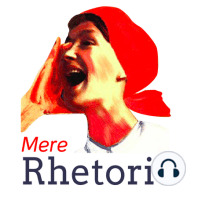12 min listen
Self: Technology and Literacy in the 21st Century
FromMere Rhetoric
ratings:
Length:
10 minutes
Released:
Sep 20, 2017
Format:
Podcast episode
Description
Welcome to Mere Rhetoric, the podcast for beginners and insiders about the ideas, people and movements who have shaped rhetorical history. I’m Mary Hedengren and today I want to start with a walk down memory lane Remember laser discs? You might not be old enough to, but I do. I remember my seventh grade science classroom had a laserdisc player and we watched just a couple of films, brilliantly bright documentaries about butterflies or some other medium-appropriate topic. I don’t remember the topic, only that it was beauitlful. But I do remember that we only had the two laserdiscs, partially because they were expensive, but partially because in just a couple of years, DVDs would become widespread and accessible. How about mini-discs? I definitely had boxes of minidiscs I had recorded from cds--I could get a cd and a half onto only one mini-disc!--and I could listen to seemingly endless music at my college early morning janitorial job. It seemed very impressive--until I bought my first iPod. This is fun. But why am I talking about technological non-starters? Because it’s so hard to guess what kind of technology will be pivotal when you’re doing research on the role of technology in our society. Things are guarenteed to change as fast as you get your book to press. Cynthia L. Selfe wrote Technology and Literacy in the Twenty-first Century in 1999 as a forward thinking volume. In 1999, mini-discs and laserdiscs were soon to fade into history, andsome of the terms she uses, like the Web to name the internet, seem almost quaint. But when technology changes all the time, the best tact, and the one Selfe takes, is to discuss principles of the technology rather than the technology itself. Selfe’s foremost claim is straightforward and applicable today as when it was written: “Literacy professionals and the organizations that represent them need to commit to understanding the complex relationship between literacy and technology and to intervening in the national project to expand technological literacy. We must also realistically appraise the multiple roles that literacy educators are already playing in support of this project” (160). The word “realistically” is key for Selfe. Technology, she points out, has always attracted boosters and boycotters. Somebody introduces, say, a wiki assignment into a composition classroom and assumes that the students will now learn collaboration and concision perfectly, while another teacher rolls their eyes, believing that such an assignment is, at best, an interesting distraction. As Selfe points out “By describing computer technology as either beneficial or detrimental, either good or bad, they limit our understanding” (36) and instead she aims for us to “understand the complex ways in which technology has become inked with our conception of literacy and, possibly, to shape the relationship between these two phenomena in increasingly productive ways” (37). So what does this word “literacy” mean anyway? We’ve talked about literacy before on the show, especially in the Deborah Brandt episode. Remember how we talked about how literacy has meant, in different times, everything from cursive to memorizing vast tracts of poetry to understanding chunks of French or Latin in the middle of a text? Cursive might not be useful at all for you now. Well, now, Selfe says, we need to think about technological literacy. She defines technological literacy as “a complex set of socialy and culturally situated values, practices and skills involved in operating linguistically within the context of electronic environments” (11). Whew. So what does that include? According to Selfe, it include reading and writing and communicating. It includes the “social and cultural contexts for discourse and communication” and it includes “print, still graphics, moving images” and “such tools as databases...e-mail, listserv software, bulletin boards, and graphics and line-art packages” (11-12). If you’re like me the first
Released:
Sep 20, 2017
Format:
Podcast episode
Titles in the series (99)
Ekphrasis (NEW AND IMPROVED: Ekphrasis Welcome to Mere Rhetoric, a podcast for beginners and insiders about the ideas, people and movements who have shaped rhetorical history. I’m Mary Hedengren and, ah, here I am in my newly redecorated research cube. I’ve taped... by Mere Rhetoric
